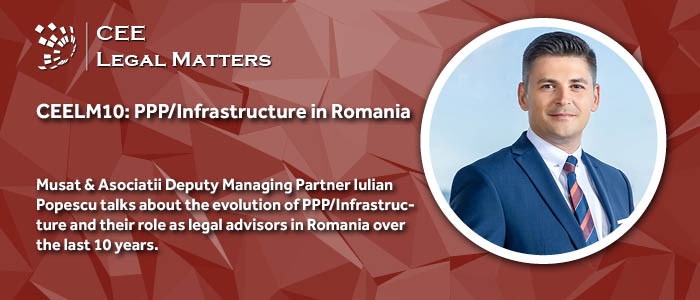Musat & Asociatii Deputy Managing Partner Iulian Popescu talks about the evolution of PPP/Infrastructure and their role as legal advisors in Romania over the last 10 years.
CEELM: Over the past decade, what types of PPP/infrastructure projects have been the primary focus for your team, and how has this focus evolved over time?
Popescu: The last decade has been transformative in terms of infrastructure development for Eastern Europe, including Romania. The region’s infrastructure needs are significant compared to Western Europe and the United States. Since Romania’s accession to the EU, there has been a real and tangible impact on infrastructure development.
Post-2010 marked a significant increase in the number and complexity of projects – the early 2010s, following the alignment of legislation and overcoming the economic crisis, marked the beginning of substantial infrastructure development in Romania.
Romania lagged in developing its infrastructure across various sectors, including roads, airports, and medical facilities. The communist era saw significant construction of industrial complexes, housing, hospitals, and educational facilities. However, this infrastructure was largely abandoned post-communism, leading to a considerable gap. The period after 2010 focused on rebuilding in line with EU standards, funded by both budgetary means and external resources.
In recent years, we’ve seen a shift in focus toward transport infrastructure, particularly highways and airport modernization, in response to increasing needs. Railway infrastructure is now gaining attention as a less polluting alternative. Additionally, waterway infrastructure development has been significant, including the Constanta port, which is crucial for handling grain imports from Ukraine and accommodating large ocean-going vessels. Internal waterways, particularly for transport from the Black Sea to the North Sea via the Danube, have also been a focus area.
CEELM: Looking back at the last 10 years, what have been your and your team’s most intense periods, and what do you believe led to them?
Popescu: The past five years have been the most intense, with a marked increase in infrastructure projects in Romania. Our team expanded significantly to meet these demands, drawing resources from various departments within our firm, such as taxes, environment, and technology. This growth is a direct result of increased European funding in the form of grants, loans, and resilience plans, which have steadily elevated our performance year over year.
CEELM: How have the client profiles evolved over the last decade?
Popescu: Our client base has diversified significantly over time, initially dominated by Western European and US companies, and increasingly featuring Romanian companies. These local companies have evolved from design-focused firms to major construction players, growing alongside our firm. The development of hospital and military infrastructure has also emerged as a new area, with the state undertaking projects for new regional mega hospitals and new or enhanced military facilities.
CEELM: And what about their needs? What new expectations do you see from clients, and what do you feel has dropped in importance?
Popescu: Client needs have evolved from basic infrastructure contract requirements to seeking comprehensive solutions encompassing financing, efficiency, and technological advancements. There’s an increasing emphasis on eco-friendly and high-tech approaches, including the use of AI and robotics. Our role has expanded from offering legal advice to educating and guiding clients through these complex projects, fostering a proactive rather than reactive approach.
CEELM: From a legislative/regulatory standpoint, what have been the main recurring challenges you have faced in projects?
Popescu: The legislative environment in Romania, particularly regarding public-private partnerships, is complex. The challenge lies not only in the legislation itself but also in its interpretation by public servants. We often work with courts to clarify and educate on these interpretations. Fiscal legislation, while initially supportive, is also evolving, necessitating continuous adaptation and education.
CEELM: What is on the horizon? What do you believe will be the highlights in a similar interview 10 years from now?
Popescu: In a decade, the focus will likely shift from building infrastructure to managing it. We expect to see more emphasis on digital transformation, environmental adaptability, and technological integration. Challenges will likely involve contract administration and productivity issues, reflecting a transition from construction to efficient management.
Musat & Asociatii is CEE Legal Matters' Practice Leader for PPP / Infrastructure in Romania for 2024 – learn more here.
This article was originally published in Issue 10.11 of the CEE Legal Matters Magazine. If you would like to receive a hard copy of the magazine, you can subscribe here.
